Biggest Influence on the German Expressionist Movement Art History Unit 9 Test
Although Germany equally a united state has existed only since the 19th century, the people referred to as High german have a long and distinguished tradition in the visual arts. The Renaissance, marked past renewed involvement in aboriginal Greco-Roman civilisation, originated in Italy in the 14th century and had spread to Frg by the following century. Albrecht Durer is regarded every bit the greatest artist of the German Renaissance. Romanticism originated in late 18th century every bit a reaction against Classicism and Caspar David Friedrich is regarded equally the most important German artist of the movement. Expressionism originated in Frg at the beginning of the 20th century and played a fundamental role in shaping the mod art world. German expressionists, led by Franz Marc and Emil Nolde, were vital in shaping the movement. Germany continues to shape the contemporary art scene with artists like Anselm Kiefer and Gerhard Richter being considered amidst the greatest in the world. Know more almost the rich history of German fine art through its 10 nearly famous artists and their greatest masterpieces.
#ten Emil Nolde

Lifespan: August seven, 1867 – April 13, 1956
Expressionism was a movement which originated in Germany and is regarded as one of the most influential fine art movements of the 20th century. Its artists distorted form and used stiff colors to limited emotional feel rather than physical reality. Die Brücke (The Bridge) was a grouping of German language artists who had a major touch on Expressionism and the evolution of modern art. Emil Nolde is the most renowned artist of this influential group. Among other things, Nolde reintroduced religious subject matter, revitalized the dwindling medium of printmaking and was i of the first 20th century painters to explore colour in detail. Emil Nolde is regarded every bit ane of the most important contributors to Expressionism, especially due to his representation of religious imagery in a new, colorful style. More than than annihilation else, his art creates a bridge from Frg'due south afar visual by to its more than radical future.
Masterpiece: Stormy Body of water (1 930 )
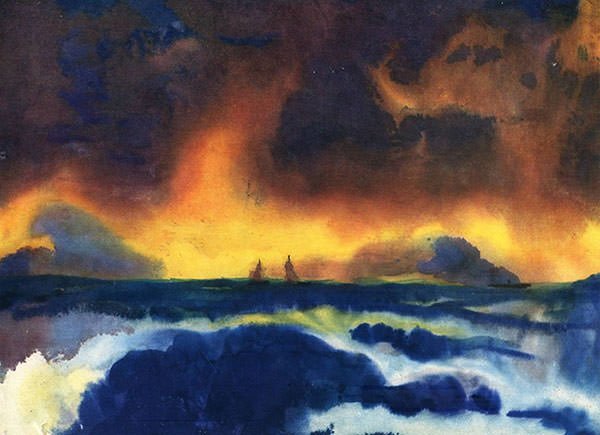
Other Famous Works:-
Mask Still Life III (1911)
The Last Supper (1909)
#9 Hans Holbein the Younger

Lifespan: 1497 – 1543
The Northern Renaissance was the Renaissance that occurred in Europe north of the Alps. German Renaissance was role of the Northern Renaissance and Hans Holbein was i of the leading artists of this motion. He belonged to a family unit of of import artists. His father Hans Holbein the Elder was an achieved painter of the Belatedly Gothic school. Hans Holbein the Younger began by creating murals and religious works. His art was prized from early in his career. He created many portraits of North European royalty and notables; and was King'due south Painter to King Henry VIII of England. Hans Holbein is renowned as one of the greatest portraitists of the 16th century and several of his portraits accept become cultural icons. His works, including his portraits and religious paintings, are marked past their compelling realism and have been executed with rare precision. Hans Holbein is considered the outstanding German artist of his generation and he remains one of the best known German painters.
Masterpiece: The Ambassadors (1533)
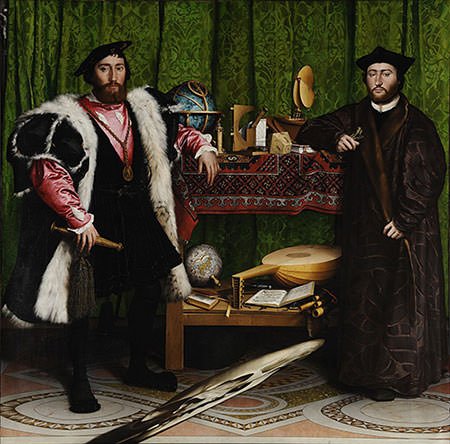
Other Famous Works:-
Portrait of Henry Viii (1537)
The Body of the Expressionless Christ in the Tomb (1522)
#viii Anselm Kiefer
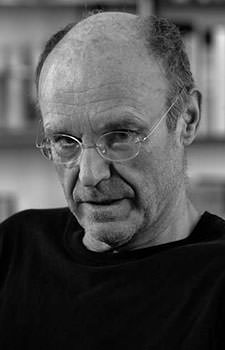
Born : March eight, 1945
Anselm Kiefer is near renowned for awe-inspiring canvases which explore German history, especially the horror of the Holocaust. These works forced his contemporaries to deal with the field of study in an era when acknowledgment of Nazism was taboo. Kiefer incorporates heavy impasto, a technique in painting where paint is laid in layers that are so recollect that the brushstrokes are visible. He uses uncommon materials in his pieces; such equally straw, ash, clay, lead and shellac. Many of these reference various aspects of history and myth, German and otherwise. He likewise incorporates text into his paintings; including excerpts from poems, novels and nationalist slogans. The entire career of Kiefer is marked by lack of hesitation in against taboos and controversial issues from contempo history. In 2005, Anselm Kiefer was awarded the Club of Merit of the Federal Republic of Germany. He remains one of the most famous contemporary High german artists.
Masterpiece: Breaking of the Vessels (1990)
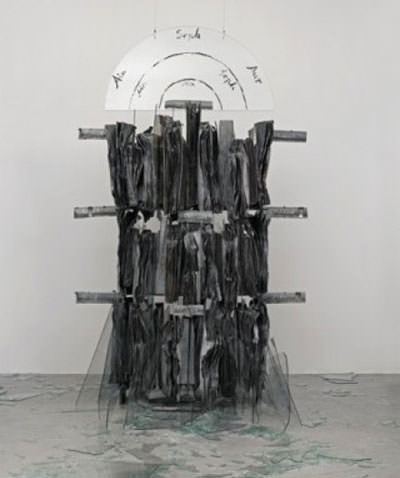
Other Famous Works:-
Heroic Symbols (1969)
Bohemia Lies by the Sea (1996)
#7 Franz Marc
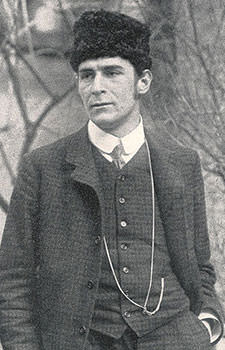
Lifespan: February 8, 1880 – March 4, 1916
Along with Die Brücke, Der Blaue Reiter (The Blue Rider) was one of two groups of German painters fundamental to Expressionism. The group pursued not-objective or abstract painting and was structured effectually the idea that color and form carried concrete spiritual values. Along with Russian painter Wassily Kandinsky, Franz Marc was the central figure of Der Blaue Reiter. He is most famous for his images of brightly colored animals, especially horses; which he used to convey profound messages about humanity, the natural world and the fate of mankind. Nature and animals were sacred to him; and he portrayed them with meditative reverence. Characteristics of his works include bold and rich primary color; stark simplicity; and deep and profound emotions. Although he died at the age of but 36, Franz Marc had a tremendous impact on Expressionism and he is one of the almost famous artists of the motility.
Masterpiece: The Large Blue Horses (1911)
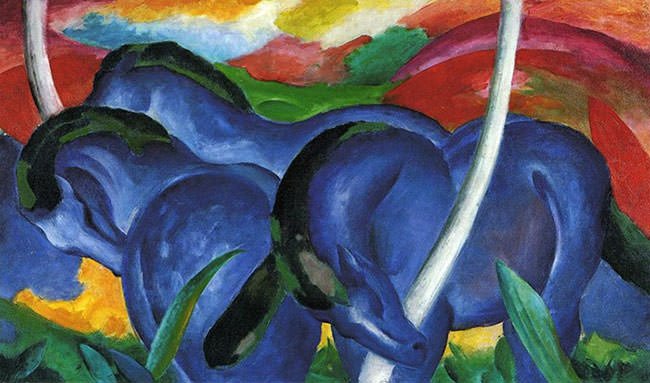
Other Famous Works:-
The Fate of the Animals (1913)
The Yellow Cow (1911)
#vi Otto Dix
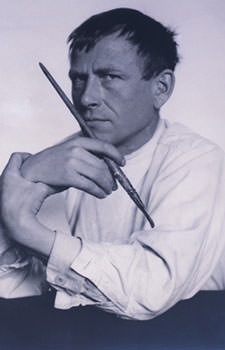
Lifespan: December 2, 1891 – July 25, 1969
Neue Sachlichkeit (New Objectivity) was a German language move that arose in reaction against Expressionism, which dominated the western fine art world at that time. Information technology rejected the introverted emotionalism and romantic longings of the expressionists; and instead sought clarity and definition through "thing-of-fact" observation of cloth reality. Forth with George Grosz, Wilhelm Heinrich Otto Dix is widely considered the virtually important creative person of the Neue Sachlichkeit movement. His paintings and drawings vividly depict and severely criticize the abuse, frantic pleasure seeking and full general demoralization of Frg post-obit its defeat in the Get-go World War, and the ineffectual Weimar Republic which governed till 1933. Otto Dix is renowned for his ruthless and harshly realistic depictions which may be seen as fell satire on the human status. He is one of the virtually famous German artists of the 20th century.
Masterpiece: The State of war (1 932 )
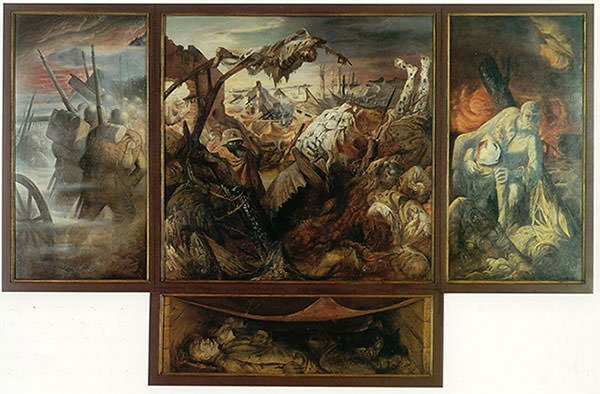
Other Famous Works:-
Pragerstrasse (1920)
Portrait of the Announcer Sylvia von Harden (1926)
#5 Gerhard Richter
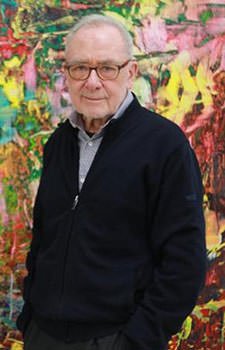
Built-in: February 9, 1932
Gerhard Richter has created a wide multifariousness of work. He has produced abstruse likewise equally photograph-realistic paintings; sculpture; drawings; photographs; and drinking glass pieces. Like Picasso, Richter has non maintained a single cohesive way and, though he has been associated with several art movements, his work cannot be put nether one particular genre. In his photo-paintings, Richter starts with a photo and projects it onto his canvas. He paints to replicate the look of the original motion-picture show and finally employs his hallmark "blur". In his abstract pictures, Richter builds up cumulative layers of non-representational painting. He begins with brushing big swaths of primary colour onto canvas. The paintings evolve in stages, based on his responses to the motion-picture show's progress: the incidental details and the patterns that emerge. Gerhard Richter has received popular and critical acclamation for his works. Many consider him to exist the greatest living artist in the world.
Masterpiece: Abstraktes Bild [599] (one 986 )
![Abstraktes Bild [599] (1986)](https://learnodo-newtonic.com/wp-content/uploads/2017/12/Abstraktes-Bild-599-1986-Gerhard-Richter.jpg)
Other Famous Works:-
Lesende (1994)
48 Portraits (1972)
#4 Albrecht Dürer
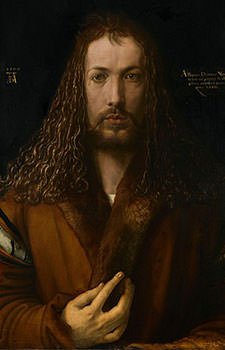
Lifespan: May 21, 1471 – April vi, 1528
Albrecht Dürer was a brilliant painter and draftsman just his greatest artistic impact was in the medium of printmaking. He started his career equally an apprentice of Michael Wolgemut, who headed a large workshop and was the leader among the artists reviving the standards of German woodcut at the fourth dimension. While still in his twenties, Durer had established his reputation and influence across Europe due to his high-quality woodcut prints. He went on to revolutionize printmaking, elevating it to the level of an contained fine art grade and he is regarded every bit one of the foremost figures in the history of printmaking. Durer was in communication with the major Italian artists of his time, including Raphael and Da Vinci. His introduction of classical motifs into Northern fine art was an important contribution to the German Renaissance. Albrecht Durer is regarded as the greatest High german creative person of the Renaissance. He exerted a deep and profound influence on the artists of succeeding generations, especially in printmaking.
Masterpiece: Melencolia I (1514)
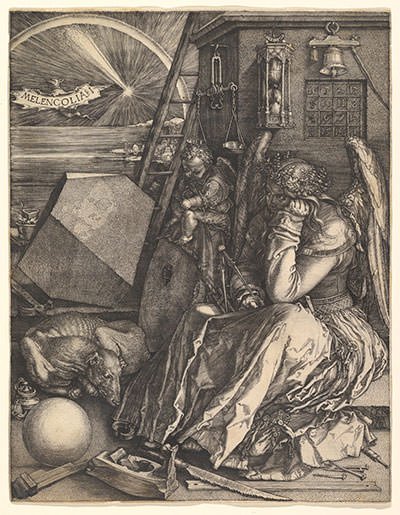
Other Famous Works:-
Self-Portrait at Twenty-Eight Years Sometime Wearing a Glaze with Fur Collar (1500)
Praying Easily (1508)
#3 Max Ernst
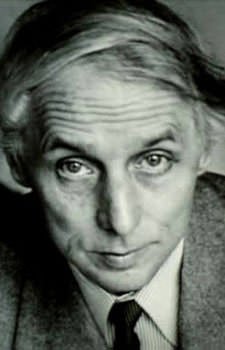
Lifespan: April ii, 1891 – Apr 1, 1976
Surrealism was an influential 20th century art movement whose artists rejected rationalism and realism; and instead focused on channeling the unconscious heed to unveil the power of the imagination. Max Ernst was a pioneer of Surrealism every bit well as the Dada motion, from which Surrealism evolved. Among the most prominent contributions of Ernst is his invention of Surrealist techniques frottage and grattage. In frottage, the creative person takes a pastel, pencil or other drawing tool and makes a rubbing over an uneven surface. The drawing can be left as it is or used as basis for farther refinement. Grattage involves laying a canvas prepared with a layer of oil paint over a textured object and so scraping the paint off to create an interesting and unexpected surface. Along with Joan Miro, René Magritte and Salvador Dali; Max Ernst is credited with being primarily responsible for creating the golden historic period of Surrealism. He is one of the most famous German modern artists.
Masterpiece: The Elephant Celebes (1921)
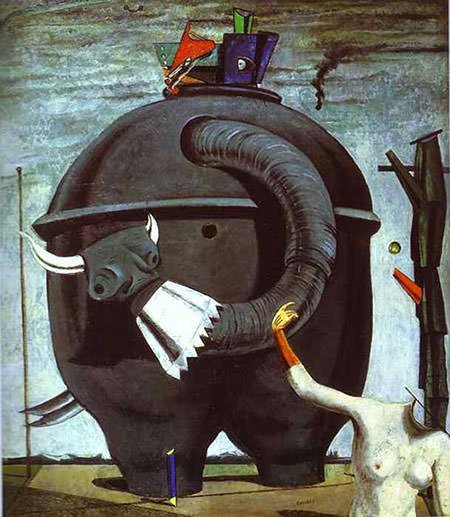
O ther Famous Works: –
Woods and Dove (1927)
Two Children Are Threatened past a Nightingale (1924)
#2 Caspar David Friedrich
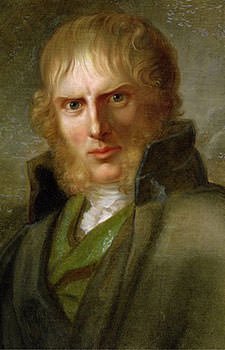
Lifespan: September 5, 1774 – May 7, 1840
Caspar David Friedrich developed a significant reputation in his early on career. Yet, his reputation declined in his later years as critics, who failed to sympathize his work, severely attacked it. He died poor and in obscurity; and it was non till the center of the 20th century that he found favor with the new generation of critics and art historians. Today, Friedrich is an icon in Germany, is internationally renowned and is considered the most important German language artist of Romanticism , an art movement that laid accent on emotion and individualism besides as glorification of the by and nature. Friedrich is viewed every bit a figure of smashing psychological complication, "a celebrator of beauty haunted by darkness". He is best known for works which put humans amidst nighttime skies, morning mists, barren copse, etc. thus illustrating diminished strength of human being in the larger scale of life. Freidrich took landscape art and infused it with deep religious and spiritual significance. He is considered one of the most important artists in the genre.
Masterpiece: Wanderer in a higher place the Sea of Fog (1819)
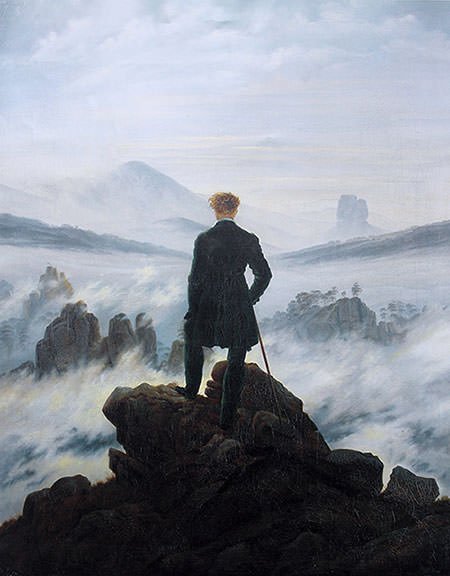
Other Famous Works:-
Monk by the Sea (1810)
The Ocean of Ice (1824)
#1 Paul Klee

Lifespan: Dec eighteen, 1879 – June 29, 1940
Paul Klee was a prolific painter who produced over 9000 works of fine art. He created nearly 500 works in 1933 and over 1200 in 1939. His artworks accept been associated with many art movements, including Expressionism, Cubism, Surrealism and Abstraction, simply it is difficult to classify them. Klee had a highly individualistic way and he is perhaps the most inventive artist of the 20th century. He interpreted art trends in his own way and used innovative methods and techniques. He worked in multiple media and even combined them into one piece of work at times. Influence of his involvement in music can be seen in his works, which too showcase his varying moods and dry humor. Klee studied the color theory and wrote about information technology extensively. Today, he is renowned as the Newton of Color. Paul Klee was i of the near influential figures in modern fine art and he is the most famous German artist.
Masterpiece: Ad Parnassum (1 932 )
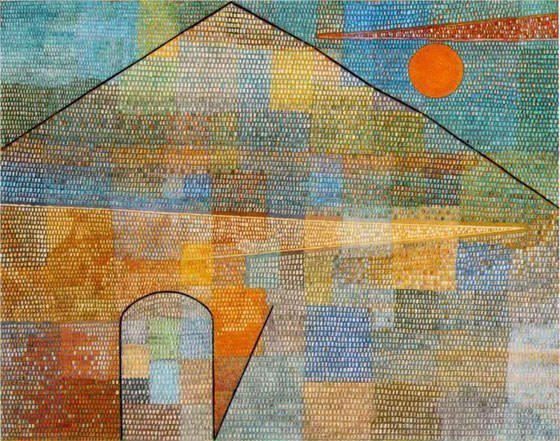
Other Famous Works:-
Twittering Automobile (1922)
Fish Magic (1925)
Source: https://learnodo-newtonic.com/famous-german-artists
0 Response to "Biggest Influence on the German Expressionist Movement Art History Unit 9 Test"
Post a Comment